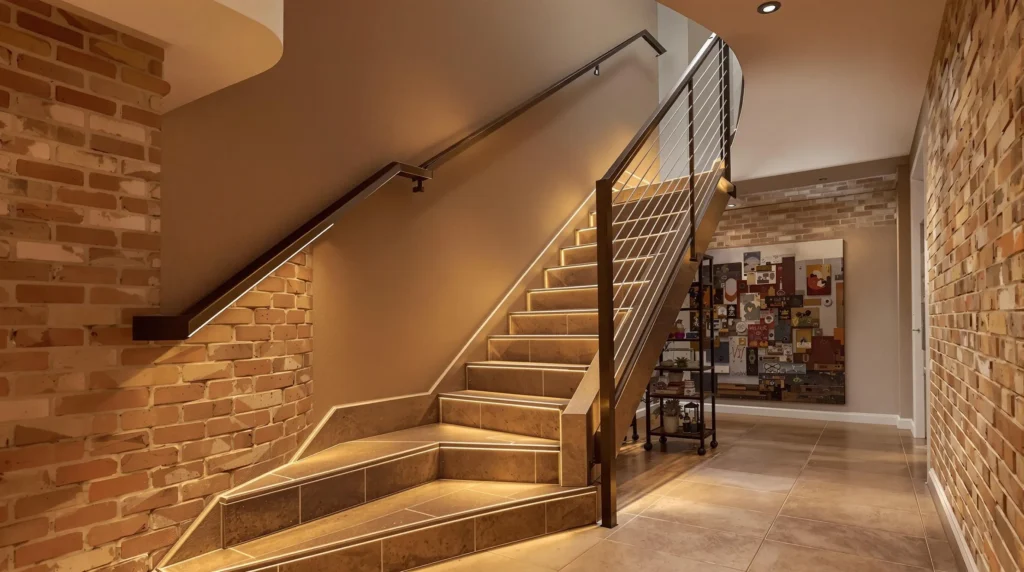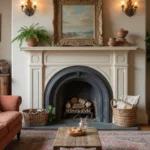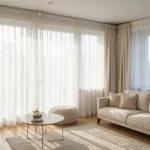We’ve all been there – staring at that awkward basement stairwell wondering how to transform it from a dark afterthought into something actually appealing. Whether you’re dealing with a cramped space that feels more like a cave entrance or an open stairway that’s begging for personality, the right design choices can completely revolutionize this often-overlooked area of your home.
Your basement stairwell doesn’t have to be the black hole of your house anymore. With smart lighting answers, creative storage options, and strategic design elements, we can help you turn this transitional space into something that actually adds value to your home. From budget-friendly DIY updates to complete makeovers, there are countless ways to breathe new life into even the most challenging stairwell.
The best part? Most of these transformations don’t require major construction or very costly. We’re about to share proven ideas that’ll make your guests do a double-take when they head downstairs.
Creative Lighting Solutions for Your Basement Stairwell
Strategic lighting transforms any dark stairwell into a welcoming pathway that enhances both safety and visual appeal. We’ve compiled the most effective illumination techniques to brighten your basement entrance.
LED Strip Lighting Installation
Installing LED strips along stair edges creates a modern safety feature that guides movement while adding ambient glow. We recommend placing these flexible light strips underneath each step’s nosing for maximum visibility and contemporary appeal. Battery-powered options eliminate complex wiring requirements and allow easy installation in just 30 minutes.
Waterproof LED strips work perfectly in humid basement environments where moisture concerns exist. Color-changing varieties let you customize the atmosphere from warm white for daily use to colored options for entertaining guests. Remote control models provide convenient dimming capabilities without additional wall switches.
Adhesive backing makes LED strip installation simple on wood, concrete, or metal stair surfaces. We suggest measuring each step carefully and purchasing 20% extra length to account for corners and connections. Professional installation costs between $150-$300 while DIY projects typically require only $50-$100 in materials.
Pendant Light Features
Pendant lighting fixtures add dramatic vertical illumination that draws the eye upward and makes narrow stairwells feel more spacious. We position these hanging lights at different heights to create visual layers throughout the descent. Industrial-style pendants complement exposed basement ceilings while sleek modern designs work well with finished spaces.
Chain-hung fixtures offer adjustable positioning to accommodate varying ceiling heights and stair configurations. Glass globe pendants distribute light evenly across multiple steps while metal cage designs cast interesting shadow patterns on surrounding walls. Multiple small pendants create more visual interest than single large fixtures.
Dimmer compatibility allows pendant lights to serve multiple functions from bright task lighting during cleaning to soft ambient lighting for evening use. We recommend installing pendants at least 7 feet above step surfaces to prevent head strikes. Edison bulb styles add vintage character while LED bulbs provide energy efficiency and long life spans.
Motion Sensor Options
Motion-activated lighting provides hands-free illumination that automatically responds to foot traffic on basement stairs. We install these sensors to trigger lights when someone approaches from either direction and turn them off after predetermined time periods. Battery-powered sensor lights require no electrical work and mount easily with screws or adhesive strips.
Infrared sensors detect body heat and movement within 10-15 foot ranges making them ideal for stairwell applications. Photocell features prevent daytime activation when natural light is sufficient while ensuring automatic operation during evening hours. Adjustable sensitivity settings accommodate different family members and pet movements.
Smart motion sensors connect to home automation systems allowing smartphone control and scheduling options. We position sensors at both the top and bottom of stairs to ensure complete coverage throughout the entire stairwell area. Professional motion sensor installation typically costs $100-$200 per unit while DIY options start around $25-$50 each.
Space-Saving Storage Ideas Under Basement Stairs
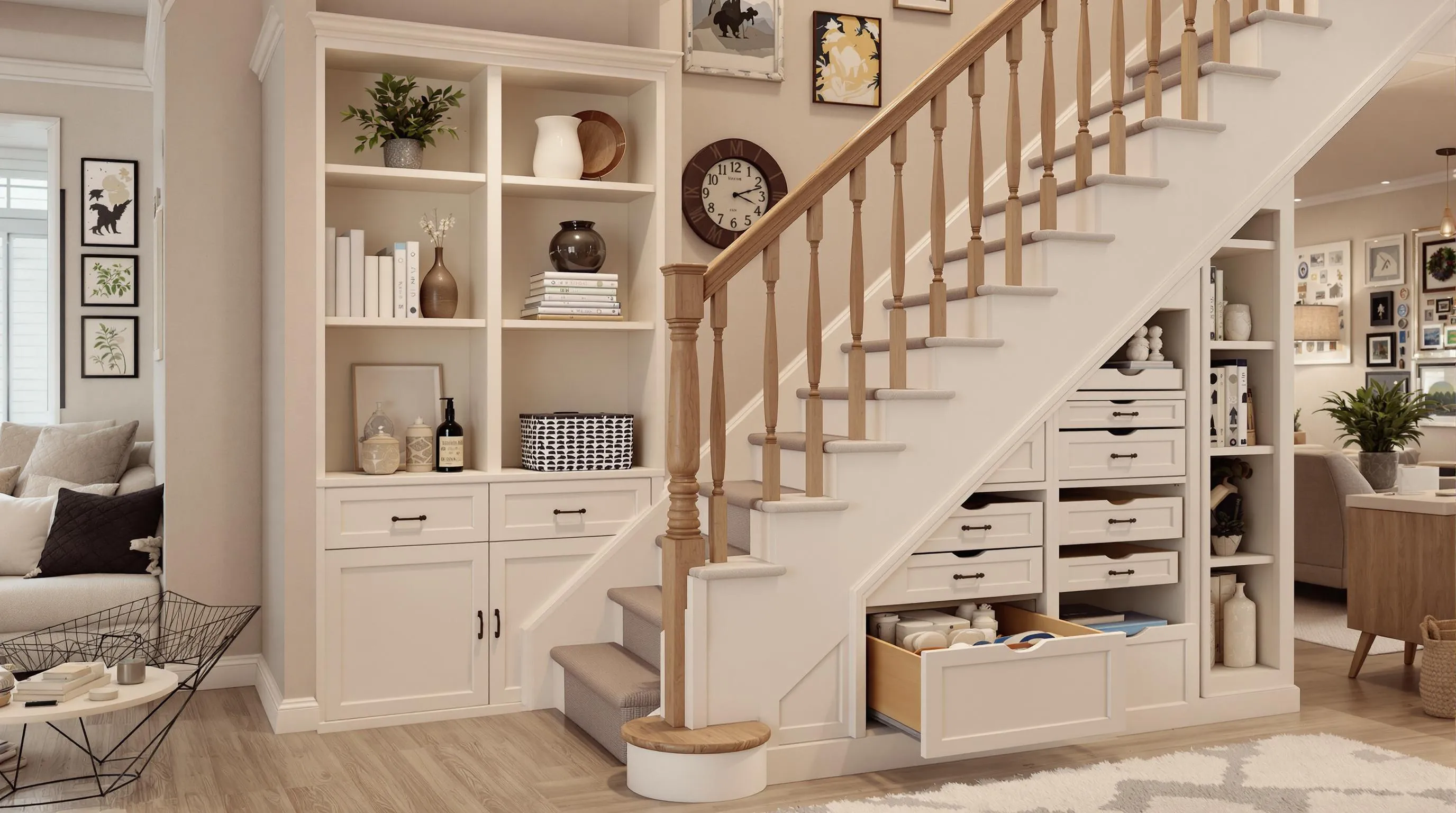
Transforming the area beneath your basement stairs into functional storage can significantly increase your home’s organizational capacity without sacrificing valuable square footage. We’ll explore three proven approaches that maximize this often overlooked space.
Built-In Shelving Systems
Built-in shelves represent the most versatile solution for basement stairwell storage, allowing you to create customized compartments that perfectly fit the angled space beneath each step. We recommend installing adjustable shelving units that can accommodate items of varying heights, from books and decorative pieces to cleaning supplies and pantry goods.
Customization becomes essential when working with the unique triangular space under stairs, as standard shelving rarely fits properly. Professional contractors can design shelving systems that follow the stair’s slope, creating multiple compartments that blend seamlessly with your basement’s existing decor.
Installation typically requires mounting brackets directly to wall studs for maximum stability, especially when storing heavier items like tools or seasonal supplies. We suggest incorporating both open shelving for frequently accessed items and closed cabinet doors for items you’d prefer to keep hidden from view.
Pull-Out Drawer Answers
Pull-out drawers offer superior accessibility compared to traditional shelving, particularly for items stored in the deepest recesses under your stairs. These sliding compartments can be installed beneath individual stair treads or designed as full-width units that span the entire under-stair area.
Functionality improves dramatically with pull-out systems, as you won’t need to crawl or reach awkwardly to retrieve items from the back corners. We recommend soft-close drawer slides that operate smoothly even when fully loaded with DVDs, light bulbs, or small tools.
Design options include flush-mounted drawers that align perfectly with your stair casing for a clean, integrated appearance. Many homeowners choose lockable drawer systems for storing valuables or items they want to keep away from children, adding both security and peace of mind.
Hidden Storage Compartments
Hidden storage compartments add an element of intrigue while providing discreet storage for valuables or items you prefer to keep completely out of sight. We’ve seen creative implementations that include concealed cabinets behind removable panels and secret doors that match existing stair finishes.
Concealment techniques range from simple hinged panels that blend with your stairwell walls to more sophisticated hidden doors operated by magnetic latches or push-to-open mechanisms. These compartments work exceptionally well for storing important documents, seasonal decorations, or emergency supplies.
Access remains convenient even though the hidden nature, as most designs incorporate easy-release mechanisms that family members can operate quickly when needed. Professional installation ensures these hidden compartments maintain structural integrity while providing years of reliable, secret storage capacity.
Modern Railing and Banister Upgrades

Modern railings and banisters transform basement stairwells from basic functional elements into stunning design features. We’ve seen homeowners achieve remarkable results by upgrading their stairwell railings with contemporary materials and sleek profiles.
Cable Railing Systems
Cable railing systems deliver a sleek and minimalist aesthetic that’s perfect for contemporary basement designs. These installations feature stainless steel cables strung between posts to create clean sight lines throughout your stairwell. We recommend cable systems for homeowners who want to maintain an open feel while ensuring safety compliance.
Stainless steel cables provide exceptional durability and require minimal maintenance compared to traditional wood spindles. Installation typically involves mounting posts at regular intervals and threading horizontal cables through pre-drilled holes. Most cable railing systems allow for easy tension adjustments to keep cables taut over time.
Industrial Pipe Railings
Industrial pipe railings bring a rugged yet sophisticated aesthetic to basement stairwells through their distinctive metal construction. These systems use galvanized or black iron pipes connected with industrial fittings to create unique geometric patterns. We’ve found that pipe railings work exceptionally well in homes with exposed brick walls or concrete floors.
Metal pipe installations offer remarkable flexibility since you can customize the configuration to match your space’s dimensions. Pipe railings typically cost less than glass panels while providing superior durability in high-traffic areas. Professional installation ensures proper anchoring and code compliance for safety.
Glass Panel Installations
Glass panel installations create an elegant and modern touch while allowing natural light to flow freely through basement stairwells. These panels can be mounted within metal or wooden frames to enhance visual appeal and complement existing architectural elements. We recommend tempered glass panels for basement applications due to their safety features and resistance to impact.
Glass railings require professional installation to ensure proper structural support and building code compliance. Maintenance involves regular cleaning to prevent fingerprints and water spots from affecting transparency. Frame materials like aluminum or steel provide long-lasting support while complementing the glass panels’ contemporary appearance.
Decorative Wall Treatments and Finishes
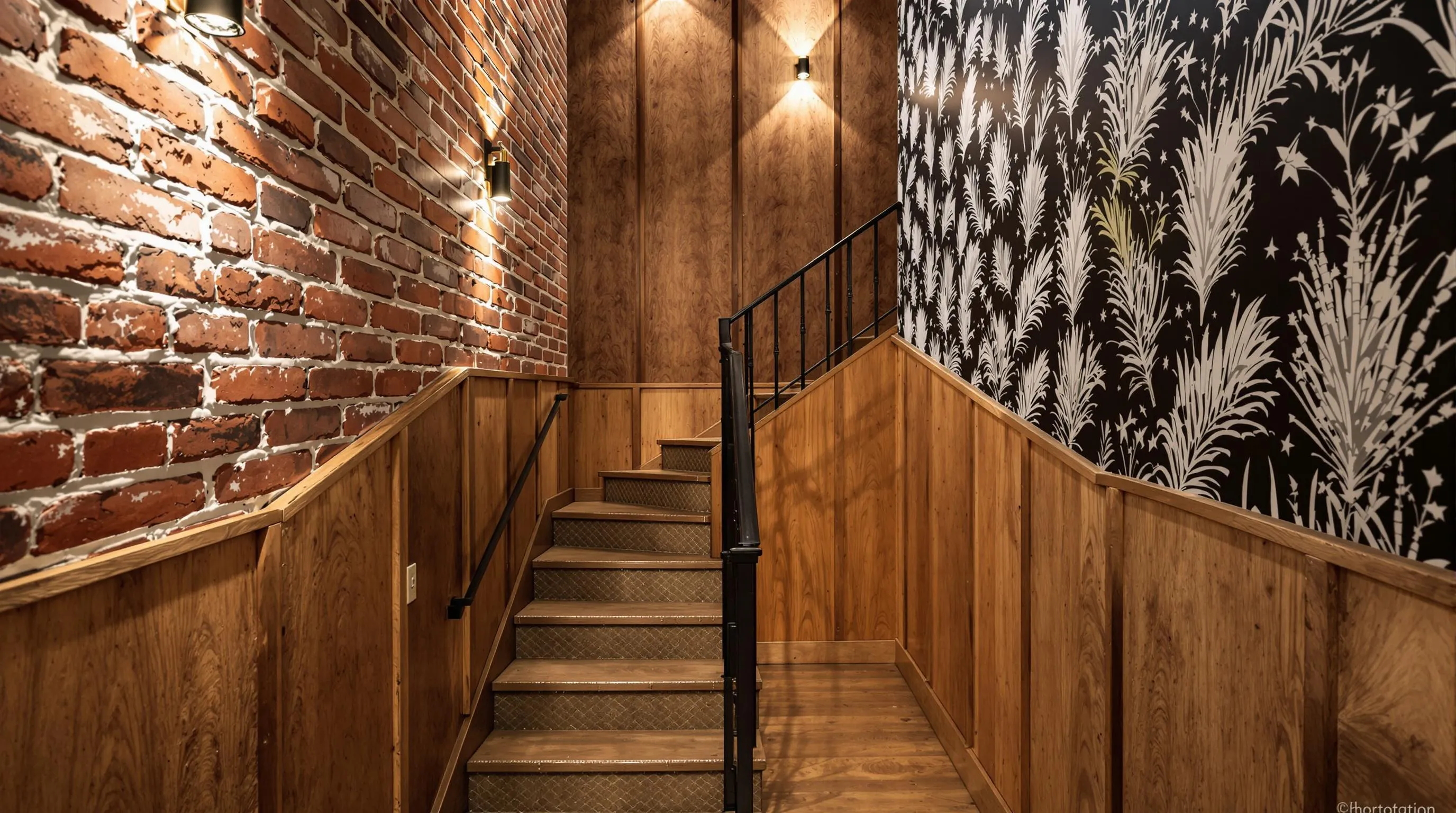
We can dramatically transform the visual impact of our basement stairwell by selecting the right wall treatments that complement our lighting, storage, and railing upgrades. These finishes serve as the backdrop that ties all design elements together while adding personality to this transitional space.
Exposed Brick Accents
Exposed brick brings rustic charm and textured warmth to basement stairwells. This treatment creates an authentic, cozy atmosphere that pairs beautifully with industrial pipe railings or cable systems. We can choose from original brick walls or install faux brick panels on one or more walls adjacent to the stairs for a striking focal point.
Original brick adds character through its natural imperfections and weathered appearance. Faux brick panels offer greater flexibility since we can install them over existing drywall without major construction. Both options contrast beautifully with smoother surfaces like painted walls or glass panel railings.
Industrial and vintage design aesthetics benefit most from exposed brick treatments. The texture catches light from LED strips or pendant fixtures, creating ever-changing shadows that enhance the stairwell’s visual depth.
Wood Paneling Options
Wood paneling adds natural warmth and versatility to basement stairwell walls. We can select from traditional tongue and groove planks, shiplap boards, or reclaimed wood for more rustic appeal. Each option brings different texture patterns and visual weight to the space.
Lighter wood tones brighten naturally dark basement areas while reflecting our LED lighting more effectively. Darker stains add sophisticated elegance and pair well with modern cable railings or glass panels. Wood paneling provides tactile contrast against metal or glass elements in our design.
Installation flexibility makes wood paneling attractive for DIY projects. We can cover entire walls or create accent panels that coordinate with our wood stair treads or handrails. This continuity unifies the design between our stairwell and main basement living areas.
Statement Wallpaper Designs
Statement wallpaper designs inject bold personality into basement stairwells through dramatic visual impact. We can choose geometric patterns, textured surfaces, or artistic prints that complement our overall design theme. Bold patterns work especially well on walls under the stairs or along narrow side walls.
Moisture resistant wallpaper ensures durability in basement environments where humidity levels fluctuate. These specialized papers withstand condensation better than standard options while maintaining their appearance over time. We should select patterns that enhance rather than compete with our lighting fixtures and railing choices.
Strategic placement maximizes wallpaper’s impact without overwhelming the space. Areas visible from the top or bottom of the stairs create memorable first impressions. Wallpaper also complements painted spindles, wood rails, and other decorative elements we’ve already incorporated into our stairwell design.
Safety Enhancements for Basement Stairwells

While we’ve transformed our basement stairwell with stunning design elements, we can’t overlook the critical safety measures that protect our family and guests. These essential upgrades ensure our beautiful space remains functional and secure for daily use.
Non-Slip Stair Treads
Installing slip resistant materials on our basement stairs dramatically reduces fall risks, especially when moisture or dust accumulates in these lower level spaces. We recommend treads made from slip resistant materials or those treated with anti slip coatings that provide continuous traction under various conditions.
Proper tread depth matters significantly for user safety and comfort. Building standards require at least 11 inches of tread depth to provide sufficient foot placement area and improve stability as we navigate the stairs. This measurement ensures our feet have adequate space to land securely with each step.
Maintenance schedules keep these safety features effective over time. We should inspect our non slip treads regularly and replace them when the slip resistant coating shows signs of wear or damage.
Handrail Height Adjustments
Building codes establish handrail heights between 34 and 38 inches, measured vertically from the stair nosing line according to United States safety standards. These measurements accommodate most users and provide optimal support for people of varying heights and mobility levels.
Secure anchoring prevents handrail failure during use and emergency situations. We must ensure our handrails attach firmly to wall studs or structural elements that can support the full weight of someone gripping them for balance or during a fall.
Professional installation guarantees compliance with local building codes and safety regulations. Licensed contractors understand the exact requirements for basement environments and can address unique challenges like moisture exposure or irregular wall surfaces.
Emergency Lighting Systems
Battery operated emergency lights provide reliable illumination during power outages when our main electrical systems fail. These units automatically activate when they detect power loss and can illuminate stairwells for several hours using their internal power sources.
Motion sensor integration creates hands free operation that activates lighting as we approach the stairs. This technology ensures we always have adequate visibility without fumbling for switches in dark basement areas.
Hardwired systems offer continuous power backup through connection to our home’s electrical panel with battery backup capabilities. These installations meet building codes for emergency egress lighting and provide the most reliable long term safety solution.
| Safety Enhancement | Key Requirement or Feature | Benefit |
|---|---|---|
| Non slip stair treads | Slip resistant material/coatings | Reduces fall risk |
| Handrail height | 34–38 inches from stair nosing | Improves user support |
| Emergency lighting | Battery or hardwired, meets codes | Ensures safe evacuation |
Color Schemes and Paint Ideas
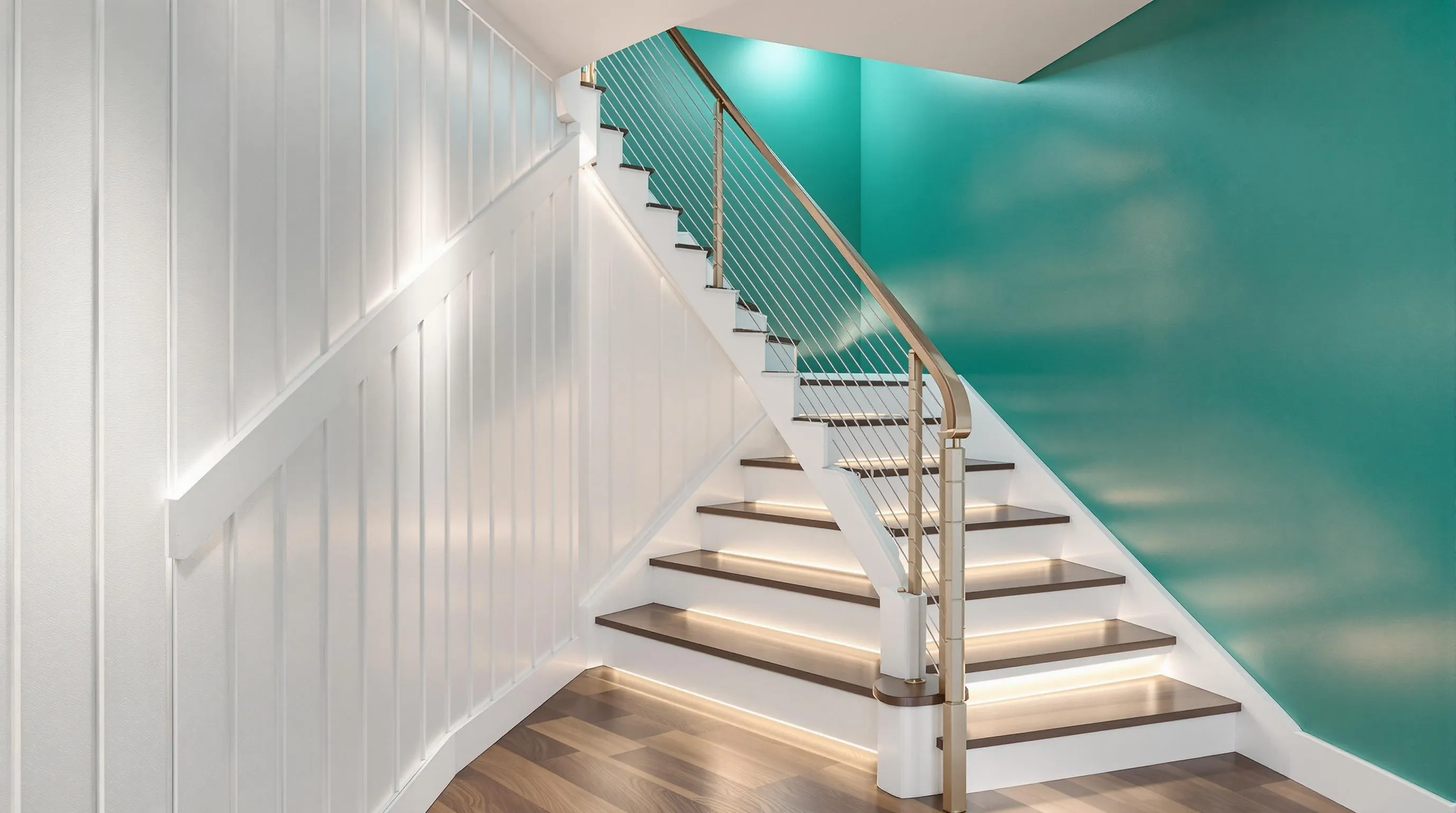
Choosing the right color scheme transforms your basement stairwell from a dark passage into an inviting transition space. We’ll explore three proven paint strategies that complement your upgraded lighting and railings while creating visual impact.
Light and Bright Palettes
Light and bright palettes create a spacious and airy feel in basement stairwells that naturally lack natural light. We recommend starting with crisp whites, soft grays, and gentle pastel shades to enhance your LED lighting systems and reflect available illumination throughout the space.
White paint serves as the foundation for most successful stairwell transformations. Pure white or warm white tones like “Cloud White” or “Simply White” amplify your motion sensor lighting and create clean backdrops for your cable railings or glass panels.
Soft grays add sophistication without sacrificing brightness. Consider light gray shades such as “Agreeable Gray” or “Classic Gray” to complement industrial pipe railings while maintaining the open feeling we’ve established with proper lighting.
Pastel accents introduce subtle color without overwhelming narrow spaces. Pale blues, gentle greens, or soft lavenders work particularly well when paired with your existing storage answers and create calming transitions between floors.
Bold Accent Wall Colors
Bold accent wall colors add visual interest and create focal points in basement stairwells without compromising the spacious feel we’ve achieved. We suggest choosing one wall, typically the longest visible surface, to showcase a dramatic hue that complements your decorative treatments.
Deep navy blues pair beautifully with white trim and enhance the modern aesthetic of cable railing systems. This classic combination creates depth while allowing your statement lighting fixtures to shine as design elements.
Rich emerald greens work exceptionally well with wood paneling upgrades and brass hardware. These sophisticated tones complement exposed brick accents while creating warmth that balances industrial elements like pipe railings.
Dramatic charcoal grays provide striking contrast against light colored stairs and highlight architectural details. This versatile choice enhances both contemporary glass panels and traditional wood banisters while maintaining visual cohesion with your safety lighting systems.
Two-Tone Stair Painting
Two tone stair painting creates visually appealing contrast while improving safety through clear definition of each step. We recommend this technique to complement your non slip treads and proper lighting while adding architectural interest to your transformed stairwell.
Light risers with dark treads offer the most popular combination for basement stairs. Paint risers in white or light gray to reflect your LED strip lighting, then use darker colors like charcoal or deep brown for treads to hide wear and create visual grounding.
Contrasting color combinations can tie your stairwell to your overall basement design scheme. Consider pairing sage green risers with natural wood toned treads, or crisp white risers with bold navy treads to echo your accent wall choices.
Gradient effects create sophisticated transitions from light to dark tones across multiple steps. Start with your lightest shade at the top and gradually deepen the color as you descend, creating visual flow that guides guests safely down your enhanced stairwell.
Flooring Options for Basement Stairs
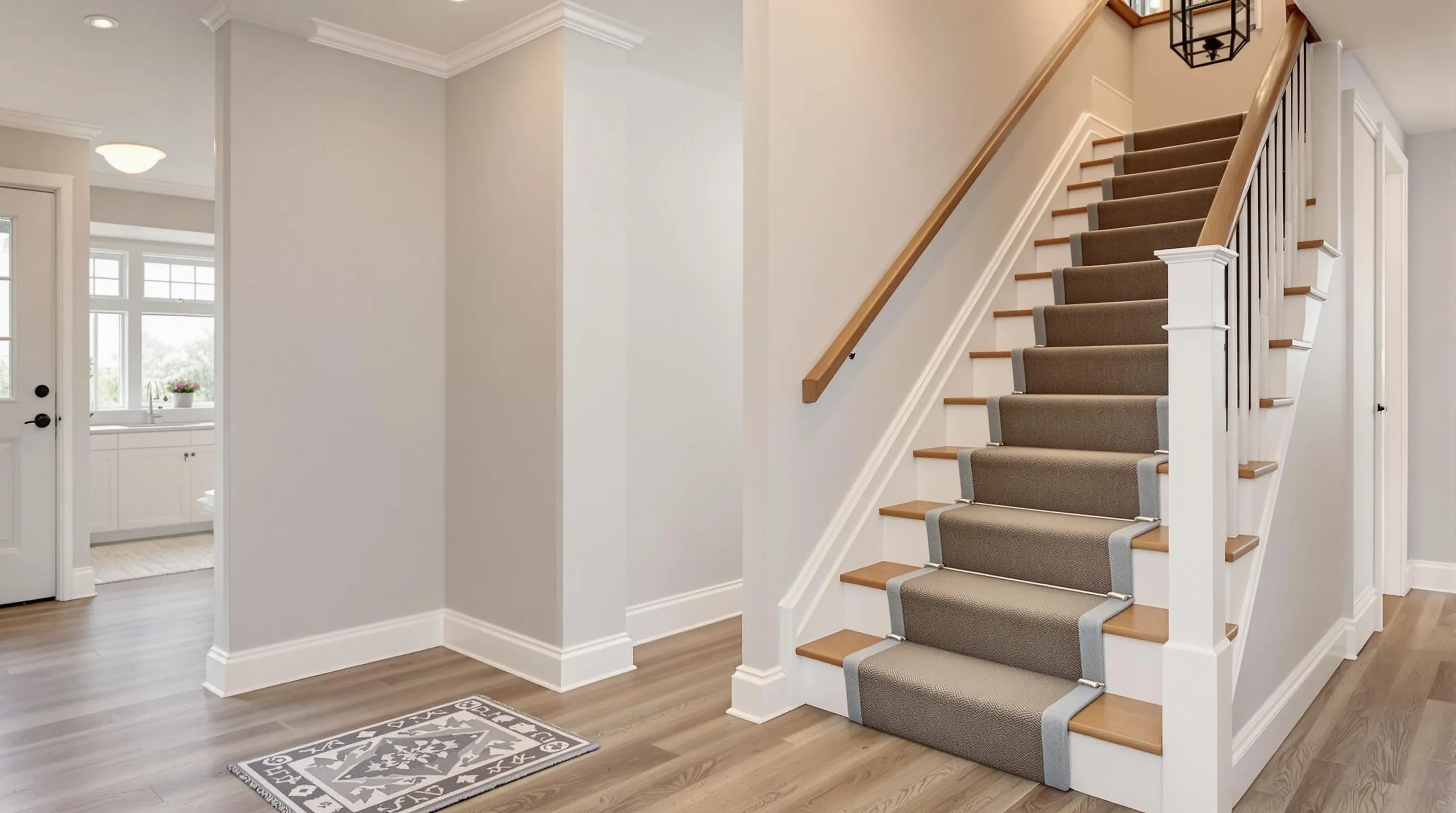
Selecting the right flooring for your basement stairs completes the transformation we’ve been building throughout this guide. The foundation beneath your feet deserves the same attention as lighting, storage, and safety features.
Carpet Runner Installations
Carpet runners deliver the perfect balance of safety and style for basement stairwells. We recommend these installations because they provide increased safety through better traction while adding comfort underfoot during frequent trips up and down the stairs.
Professional installations typically include a non-slip underlay that prevents the runner from shifting during use. Secure fastening at each step ensures the carpet stays in place even with heavy foot traffic. Popular choices include patterned runners that can add color coordination with your existing wall treatments and railings.
Modern carpet runners come in moisture-resistant materials specifically designed for basement environments. We’ve found that synthetic fibers like nylon and polypropylene work best because they resist mold and mildew growth in humid conditions.
Hardwood Stair Refinishing
Hardwood stairs offer unmatched elegance that complements the modern upgrades we’ve discussed throughout this transformation. Refinishing involves a three-step process of sanding, staining, and sealing to restore or completely update the appearance of existing wooden stairs.
Professional refinishing typically costs between $300 to $600 for a standard basement staircase depending on the wood type and complexity. We recommend combining hardwood stairs with carpet runners for enhanced safety while maintaining the refined aesthetic.
Oak and maple stairs respond particularly well to refinishing because of their dense grain structure. Staining options range from light natural tones that match our recommended bright color palettes to rich dark finishes that create dramatic contrast with white railings.
Vinyl and Laminate Answers
Vinyl and laminate flooring provide cost-effective alternatives that excel in moisture resistance for basement environments. These materials install easily over existing stairs without requiring extensive preparation or removal of current flooring.
Modern luxury vinyl planks and laminate options convincingly mimic hardwood, stone, and tile appearances while offering superior protection against dampness concerns common in below-ground spaces. We’ve seen installations that perfectly complement the industrial pipe railings and contemporary design elements popular in basement renovations.
Installation costs typically range from $150 to $400 for materials and basic installation on standard basement stairs. Professional installation ensures proper moisture barriers and expansion gaps that prevent buckling in humid conditions.
Composite and engineered wood alternatives offer similar moisture resistance with authentic wood appearance. These materials provide enhanced stability compared to traditional hardwood while maintaining the warmth and character that complements your lighting and storage upgrades.
Multi-Functional Basement Stairwell Designs
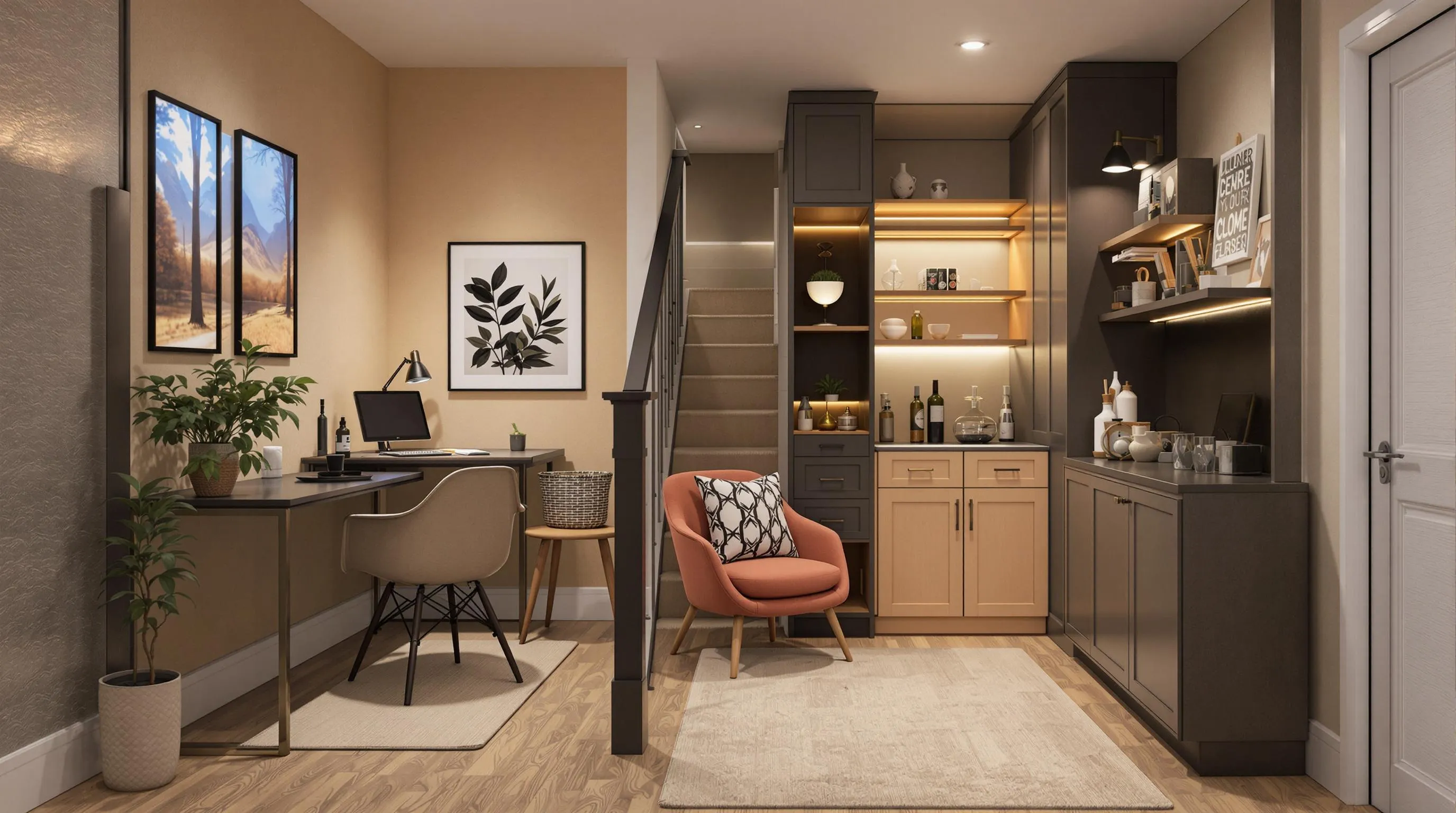
We can transform underused basement stairwells into hardworking spaces that serve multiple purposes beyond simple circulation. Creating functional zones within these areas maximizes our home’s potential while maintaining the aesthetic improvements we’ve already implemented.
Home Office Nook Creation
Compact desk installations under basement stairs create productive workspaces without requiring dedicated rooms. We recommend selecting desks that fit naturally within the triangular space, allowing for comfortable seating while maintaining walking clearance on the stairs above.
Proper lighting becomes essential for productive work sessions in these converted spaces. Task lighting such as adjustable desk lamps or under cabinet LED strips provides focused illumination that complements our existing stairwell lighting upgrades.
Storage answers integrate seamlessly with office nooks through wall mounted shelves and compact filing systems. Floating shelves accommodate books, office supplies, and decorative items while keeping the workspace organized and clutter free.
Cable management systems help maintain the clean aesthetic we’ve established throughout our stairwell transformation. Running cables through the existing framework or using adhesive cable organizers keeps technology wires hidden from view.
Reading Corner Setup
Cozy seating options transform basement stairwells into intimate reading retreats that invite relaxation. Bean bags, compact armchairs, or built in bench seating provide comfortable spots for enjoying books while utilizing previously wasted space.
Bookshelf installations near reading areas keep favorite titles within easy reach. Wall mounted shelving or corner bookcases work particularly well in these spaces, creating visual interest while serving practical storage needs.
Soft lighting creates the perfect ambiance for extended reading sessions. Warm LED fixtures, floor lamps, or battery operated sconces provide gentle illumination that reduces eye strain and enhances the cozy atmosphere.
Cushions and throws add comfort elements that make reading corners more inviting. Selecting moisture resistant fabrics ensures these accessories remain fresh and appealing in basement environments.
Mini Bar Installation
Compact bar units maximize entertainment potential in basement stairwells without overwhelming the space. Wine coolers, mini refrigerators, or floating bar shelves create sophisticated serving areas that complement our upgraded railings and lighting.
Elegant lighting fixtures enhance the bar area’s ambiance during entertaining. Pendant lights, under cabinet strips, or decorative sconces create mood lighting that makes these spaces feel like upscale lounges.
Storage incorporation through cabinets and shelving keeps glassware, bottles, and bar accessories organized and accessible. Glass front cabinets showcase attractive barware while closed storage conceals less decorative items.
Countertop materials should coordinate with our existing finishes while providing durability for beverage service. Butcher block, quartz, or reclaimed wood surfaces add warmth and functionality to these entertaining spaces.
Budget-Friendly DIY Basement Stairwell Projects

Transforming your basement stairwell doesn’t require a massive budget or professional contractors. We’ll explore three proven DIY approaches that deliver impressive results while keeping costs manageable.
Painted Stair Makeovers
Painting basement stairs offers the most straightforward path to dramatic transformation on any budget. We recommend starting with a thorough cleaning and light sanding to ensure proper paint adhesion. Light colors like crisp whites or soft grays work best for creating an airy atmosphere that complements your upgraded lighting features.
Two tone painting techniques add visual interest while improving safety navigation. We suggest using darker colors on treads and lighter shades on risers to define each step clearly. White spindles paired with wooden handrails create a fresh, timeless look that brightens even the darkest stairwells.
Combining painted surfaces with carpet runners enhances both style and slip resistance. We’ve found that semi gloss or satin finishes hold up better in high traffic areas than flat paints. Professional painters typically charge $200-400 for complete stair painting, but DIY enthusiasts can achieve similar results for under $50 in materials.
Rope Railing Alternatives
Rope railings deliver unique character while maintaining budget consciousness for creative homeowners. We recommend marine grade rope for durability, especially in moisture prone basement environments. Natural fiber ropes like manila or sisal provide rustic warmth, while synthetic options offer superior longevity.
Installation involves mounting eye bolts or rope cleats at regular intervals along your existing posts. We suggest spacing attachment points every 6-8 inches to prevent excessive sagging. Nautical inspired designs work particularly well in finished basements with coastal or industrial themes.
Cost effectiveness makes rope railings attractive compared to traditional balusters or cable systems. We typically see material costs ranging from $30-80 depending on stairwell length and rope quality. Maintenance involves periodic tightening and replacement every 3-5 years based on usage patterns.
Removable Wallpaper Applications
Removable wallpaper revolutionizes basement stairwell decoration by offering commitment free style updates. We recommend moisture resistant vinyl options that withstand typical basement humidity levels. Bold patterns inject personality into narrow spaces without overwhelming smaller areas.
Riser applications create stunning visual impact while remaining completely reversible. We suggest geometric patterns or wood grain designs that complement your existing flooring choices. Accent walls behind stairs add depth and interest without requiring permanent modifications.
Seasonal changes become effortless with peel and stick options that remove cleanly. We’ve found that quality removable wallpapers cost $25-60 per roll and cover approximately 20 square feet. Installation requires only basic tools like smoothing brushes and utility knives, making this approach accessible for any skill level.
Smart Technology Integration Ideas
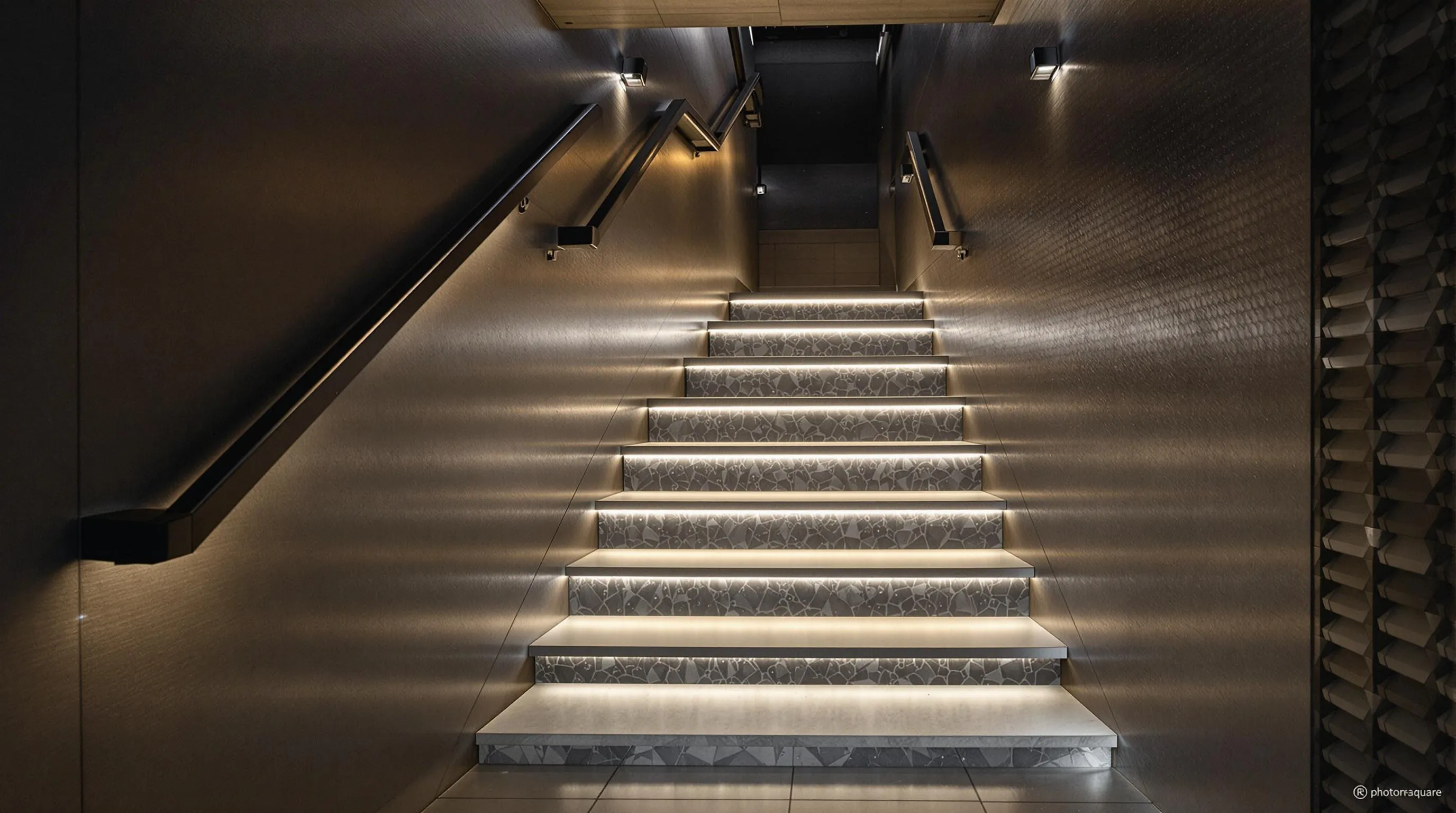
Smart technology transforms our basement stairwells into modern, secure spaces that respond intelligently to our daily routines. These automated systems enhance the safety and convenience we’ve already built through lighting, storage, and design upgrades.
Automated Lighting Controls
Motion sensors eliminate the fumbling for light switches when our hands are full with laundry or storage items. These smart devices instantly illuminate the stairwell as we approach, reducing fall risks and creating seamless transitions between floors. We can connect motion-activated lights to smart home systems like Alexa or Google Home for complete customization throughout the day.
Smart LED bulbs offer voice control and scheduling capabilities that complement our existing lighting design. These energy-efficient options gradually brighten in the morning or dim at night, adapting to our family’s rhythm while maintaining the ambiance we’ve created. Programming custom schedules ensures our stairwell lighting matches our household’s peak usage times.
LED strip lighting along each stair tread provides continuous illumination without harsh glare. This subtle approach enhances the safety features we’ve already installed while maintaining the aesthetic appeal of our decorative treatments. Battery-powered strips offer installation flexibility, while hardwired options integrate seamlessly with our home’s electrical system.
Security Camera Placement
Strategic positioning at the top and bottom of our stairwell captures complete coverage of this often-overlooked access point. These cameras monitor anyone entering or exiting the basement, providing peace of mind about our family’s security. Discrete, recessed models blend with our existing design elements without disrupting the visual flow we’ve carefully created.
Smart home integration allows real-time monitoring through our smartphones or security systems. We receive instant alerts when motion is detected, keeping us informed whether we’re home or away. This technology complements the safety enhancements we’ve made with non-slip treads and proper handrail installations.
Wireless cameras eliminate the need for extensive wiring, preserving the clean lines of our decorative wall treatments. These systems connect to our home Wi-Fi network, storing footage in the cloud for easy access and review. Professional installation ensures optimal angles while maintaining the polished appearance of our renovated stairwell.
Smart Switch Installations
Voice and app control replace traditional switches with modern convenience that matches our upgraded design aesthetic. We can illuminate the stairwell remotely before heading downstairs, especially helpful when carrying items or during evening hours. These switches integrate with existing smart home ecosystems, creating unified control over our basement’s lighting systems.
Scene programming allows us to create custom lighting moods that enhance different activities in our multi-functional stairwell spaces. “Movie mode” dims the lights for entertainment areas, while “welcome mode” provides full brightness for guests. These preset combinations work seamlessly with the color schemes and flooring choices we’ve implemented.
Energy efficiency features include automatic timers and occupancy sensors that turn lights off when the stairwell is empty. These smart controls reduce electricity costs while maintaining the enhanced functionality of our modernized space. Installation connects easily to our existing electrical work, building upon the foundation we’ve established through previous upgrades.
Conclusion
Your basement stairwell transformation journey doesn’t have to end here. We’ve shown you that even the most overlooked spaces can become stunning focal points with the right approach and planning.
The beauty of these upgrades lies in their flexibility – you can tackle them one project at a time or combine multiple elements for maximum impact. Whether you’re working with a tight budget or ready for a complete overhaul there’s a solution that fits your needs.
Remember that every home is unique and what works best for your space depends on your exact layout traffic patterns and personal style. Start with the improvements that excite you most and watch as your basement stairwell evolves into a space you’ll actually look forward to using.
Your guests will definitely notice the difference and you’ll enjoy the added functionality and value these thoughtful upgrades bring to your home.
Frequently Asked Questions
What are the most effective lighting options for basement stairwells?
LED strip lighting along stair edges provides excellent safety and ambiance, with battery-powered and waterproof varieties available. Pendant lights create visual interest in narrow spaces, while motion sensor lighting offers hands-free illumination with smart home integration options. These solutions range from DIY installations to professional setups.
How can I maximize storage space under my basement stairs?
Three proven approaches include built-in shelving systems for versatile organization, pull-out drawers for easy access to deeper areas, and hidden storage compartments for valuables. These solutions can be customized to fit the triangular space while blending seamlessly with your existing decor.
What railing upgrades work best for modern basement stairwells?
Cable railing systems offer sleek, minimalist aesthetics with low maintenance requirements. Industrial pipe railings provide rugged sophistication at cost-effective prices. Glass panel installations allow natural light flow while maintaining safety. Professional installation is recommended for safety compliance and building code adherence.
Which wall treatments can transform my basement stairwell’s appearance?
Exposed brick accents add rustic charm and texture, while wood paneling brings warmth and versatility. Statement wallpaper with bold patterns injects personality, but ensure moisture-resistant options for durability. Select treatments that complement your lighting, storage, and railing upgrades for cohesive design.
What safety features should I prioritize in my basement stairwell?
Install non-slip stair treads to reduce fall risks and maintain proper tread depth. Adjust handrail heights to meet building codes for optimal support. Include emergency lighting systems with battery-operated or hardwired options for reliable illumination during power outages.
What color schemes work best for basement stairwells?
Light and bright palettes using whites and soft grays create an airy feel and reflect light effectively. Bold accent walls add visual interest as focal points. Two-tone stair painting improves safety by clearly defining steps while adding architectural appeal.
Which flooring options are most suitable for basement stairs?
Carpet runners with moisture-resistant synthetic fibers provide safety and style. Hardwood refinishing restores elegance to existing stairs. Vinyl and laminate offer cost-effective, moisture-resistant alternatives that mimic wood appearance. Professional installation ensures proper moisture barriers and stability.
Can I create functional spaces within my basement stairwell?
Yes, consider compact home office nooks under stairs with proper lighting and storage. Cozy reading corners with comfortable seating and bookshelves work well. Mini bar installations enhance entertainment potential. Each design should incorporate thoughtful lighting and storage solutions for functionality.
What are some budget-friendly DIY projects for stairwell transformation?
Painted stair makeovers using light colors or two-tone techniques provide dramatic, cost-effective results. Rope railings offer unique, affordable alternatives to traditional options. Removable wallpaper allows commitment-free style additions. These projects are accessible and manageable for most homeowners.
How can I integrate smart technology into my basement stairwell?
Install automated lighting controls with motion sensors and smart LED bulbs for hands-free illumination. Add security cameras with discreet models that blend with decor for monitoring. Smart switch installations enable voice and app control for remote lighting management and energy efficiency.

